Living here in the Sunshine State, it seems that folks have an unusual penchant for $0.69 sq. ft. 20″ tiles. The most popular colors are blah, boring, and blech. People love to toss these tiles down over red oak, irreplaceable heart pine, and any number of historic floors.
These tiles are spreading like a wildfire across the floors of historic homes. Something must be done! Which brings us to our number 2 worst mistake of historic homeowners…
Flooring
Historic houses are having their floors covered up, ripped out, or trashed in any number of ways to make room for newer, inferior products. Only in America would we be ignorant enough to cover what would be a $15 or $20 per sq. ft. floor with a $.50 per sq. ft. floor. Are we really that shallow? Historic homes have some of the finest flooring available. Have you ever seen a 70 year old vinyl floor? I didn’t think so. How about laminate flooring that has made it even 30 years? Me neither.
Todays floors, even the top quality ones, come with 25 and even 40 year warranties which isn’t too bad, but why would you replace a floor that will last centuries with one that lasts only a third that long?
And in today’s real estate market, most of us are being ever mindful of home values. The typical buyer of an old or historic home is expecting hardwood floors. “Maintenance-free” tile is not a selling point for these kind of houses. And while a click-lock engineered wood or laminate floor may be considered an upgrade on a new home, it is a definite cold shower to your historic home’s market price. The jura hausarbeit ghostwriter shared one fact with me. Some homeowners, when selling a historic home, enter into a legal contract where they describe that the floor cannot be replaced because it is historic property.
Wood Floor Restoration
Wood floors are prime candidates for refinishing and restoration. If you have pet stains, loose/missing boards, rot, termite damage, or other issues, these are simple repairs for a flooring professional. And if you get someone who says your floors aren’t repairable, they are most likely either too lazy to do the work or trying to sell you new floors. Either way, RUN! I have yet to come across a solid wood floor that couldn’t be repaired. The same is almost never true for tile, laminate, vinyl or even engineered wood floors.
Probably one of my favorite jobs restoring a floor was this 1920s heart pine I came across. The home had been used as a business for a time and apparently there had been some damage to the original floors that was patched…well, let’s just say poorly, and then carpeted over. When the new homeowner found the damage she intended to tile over the entire house with the afore mentioned tile.
I was referred to her when her tiling was about halfway done and convinced her (read: begged) her to save the remaining floors because they were not beyond repair. A week later after replacement boards were installed and the floors were refinished, she had what looked like new floors!
Solid wood flooring, like this, found in most historic homes is extremely resilient. It can handle multiple refinishings (done properly) over its life and is easy to repair in a way that is almost certainly unnoticeable. And what’s best is that it can last hundreds of years with minimal care!
So, before you jump to “upgrade” the flooring in your historic home, take a minute and think it over. Do you want a different color? Stain it. A different glossiness? Refinish it. You can even paint your wood floor to look like almost anything. The only boundaries are your own imagination. And if you are wondering if your floor can be repaired, the answer is almost always “Yes!” Search around for a hardwood refinishing specialist or restoration company and you will find someone up to the task of rejuvenating your floors. And trust me, it will be worth it!
Tired of the same old wood floors? You can make quite a statement with some stain or paint. I’ve included some fun ideas of what others have done with their hardwood floors. Get creative!
You can also learn more about the history of hardwood floors in our post A History of Wood Floors
Read the rest of the 5 Worst Mistakes of Historic Homeowners:

Founder & Editor-in-Chief
I love old houses, working with my hands, and teaching others the excitment of doing it yourself! Everything is teachable if you only give it the chance.

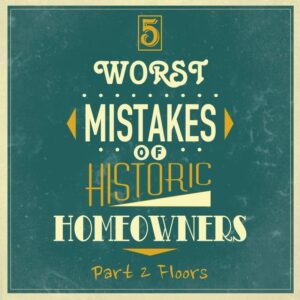
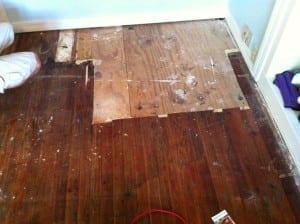
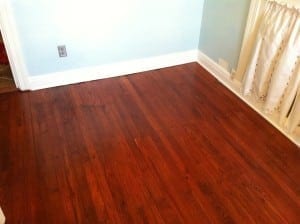
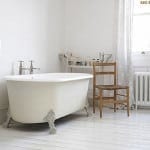
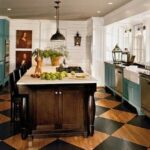
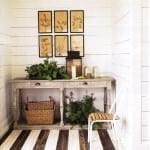
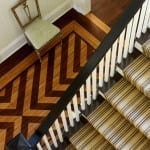
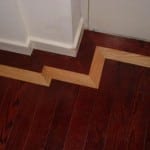
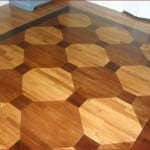


This happened to a newer home I renovated then sold. I installed tongue and groove hardwood cherry flooring in the home’s living room in 2007 over a plywood sub-floor. The cherry was outrageously expensive, costing $11./foot. It was absolutely gorgeous. Because the new owners wanted to remove the wall between the kitchen and the living room and could not match the cherry, they tore it out and threw it away. They replaced it with a vinyl fake wood. I was shocked.
Ahhhhhh!!!
I just bought a 1912 California bungalow. it has heartwood pine floors. One of the bedrooms has floor covering on the heartwood pine. I was wondering if you have ever flipped the flooring and refinish the (what was) bottom side of the original heartwood pine flooring. I’m trying to be as sustainable as possible and want to keep as much of the original component of the 1912 home as possible.
It’s extremely difficult to pull up on old floor like this without damaging the boards (especially the bottom of the boards) because of how they’re typically nailed at an angle thru the tongue. Plus you typically cannot flip wood flooring because it is machined differently on the bottom and the tongue/groove may not be centered in the thickness of the material. I would talk with a professional floor refinisher and see if they think they can salvage it. I’ve heard some people have hired sandblasters to come in and strip adhesive materials off wood flooring, maybe this or some chemical stripper would be an option? Again, in this case I would talk to a pro.
Thank you for the information .
Scott-
Any suggestions for a 1923 kitchen floor replacement? It has old vinyl (not original) currently and just a wood base beneath.
In my 1925 Bungalow in Tampa I used in the kitchen Armstrong Tiles (believe they are made of abestos). i used 3 different colors in a random looking pattern on the dinal. It looks amazing and very representative of period and very durable. Tons of colors. I ordered from Home Depot. I was not able to save floors in my house because of previous owner had very bad termite infestation and she thought it was just wood rot. ? Currently looking for pet friendly alternative for reat of house that works for raised foundation.
HI Scott and all– What can I do about loud squeaks? I just removed carpet in my 1935 house and found very nice hardwood floor in very good condition, but it squeaks very badly all over the dining room. It can really stay as is but I would not want to lose the floor because of this.
Maria, try this post: https://thecraftsmanblog.com/how-to-fix-creaky-wood-floors/
We have restored (more like rebuilt) an old, late 1800s, rock cabin that was on our farm when we bought it 35 years ago. Interior dimensions are about 40×15 feet and it has 14-inch thick limestone walls. Windows are made from reclaimed longleaf pine and have the old style rope and pulley with weights. The floor is the last major step for completion. We have a very solid pier and beam foundation recently built within the walls. The subfloor is 3/4-inch Advantec with 1/2 inch added to the top to enable us to run the floor parallel to the joists.
Except for the windows, it is pretty air tight. There is no AC and it will have a wood burning stove that will be used only when we use the building. Our question is what would be the best hardwood floor to use since the temps and humidity will be unchecked? Some sales people have said don’t use engineered because the layers will eventually peel apart. Others say use engineered because it is more stable than solid. One salesperson told us there is no way to use solid or engineered because of the lack of humidity control. We find that hard to believe since hardwood floors were around long before houses had AC.
Do you have an opinion on this or any installation tips?
Scott,
Enjoying the site. I am a restorer as well. Currently re-restoring our 100 year old farm house in VA after a lightening strike and fire. Salvaged most of the 6/6 windows and found more across Virginia salvage yards. Rebuilding them is going well. It’s the floors I am stumped on.
Salvaged the heart pine floors mostly. Demo contractor broke a lot of the tongues. They had been sanded and poly’d the first go round so they are now 5/8. I have a ton of 3/4, 1, 1 1/8, 1 1/4 100+ yr old T&G in various widths (2 1/4″-20″) and lengths. Some have a cup, some a bow. In order to have them line up with the old flooring I would have to plane them all down to 5/8″, a lot of material coming off and a lot of work. Also thinking of ripping them to 3 different widths then T&G on the router table for ease of installation, alternating the different widths in the layout. Wondering what you think of this approach. Alternate approach would be to straighten and rip as above and face nail boards with reproduced cut nails saving time on T&G.
Finally, given that the old sanded and poly’d floors are so thin now, we were thinking of just cleaning them up and waxing the entire house, old re-installed and planed reclaimed wood. Really appreciate your response. Procrastinating because of this indecision of what to do with the flooring.
Cheers
Jim
Hello Scott. We have a house in Nokomis Illinois that was built in 1920. It is the original plantation house for the 16+ blocks surrounding it. It has all of the original interior woodwork including 2 sets of very functional pocket doors with original tracks and frames. Almost every window frame. Interior doors and frames. Some door frames have the opening transom windows up top. The house is even complete with all of the original hardwood floors. I know people will absolutely hate me for this. But we want to renovate to my sons liking as he is buying the house from us after boot camp My husband and I know that when people are trying to restore an old home, the hard wood trim and interior pieces and the stained glass windows are the hardest parts to come across. We also know that if we try to take it out ourselves, or even if some crews with the younger workers take it out, it will inevitably be destroyed. Do you know of anyone that will but the stuff out of our house for a reduction in price and put in new door frame and such? can email some pictures
Hi Pamela,
Thanks so much for reaching out and reading our blog! We have a directory on our site ( https://thecraftsmanblog.com/directory/ ) with a network of people all over the country who do work similar to what we do. Hopefully you can find someone in your area who is better able to answer your questions upon seeing it in person than we can online. Best of luck to you!
-Alyssa at The Craftsman Blog
Hi scott! I’m the proud owner of a 1920s huge SpAnish multi unit in LA, who bought from a guy who always did the cheapest modifications possible. Judging from the weird lip that has been created at my stairs, my living room appears to have four layers of hardwood stacked one on top of the other (the most recent looks very 80s). Is it worth trying to peel away the layers or should I just refinish the 80s business? I don’t know much about laying floors… would they have been glued together? I’d gain a few inches of height back, but…
I bought my first house! 1955 brick ranch. Looks like they carpeted the entire life of the house and from the corners I’ve pulled back the floors look to be in excellent condition. Is there any chance I won’t need to refinish them? I cannot afford that cost but need the gross carpet gone!
Hi there,
I just bought a 1950’s ‘cabin’/ranch in the mountains of Northeren CA. It’s a mojor fixer and tiny, but it’s home now! In tearing out the carpet at the back porch, I noticed that the porch flooring is the same as (and continues into) the inside flooring. The porch is painted but it looks to be 2X6 T&G fir. The inside is covered with 3/8″ plywood and I don’t want to pull that up until I know that it’s ok to refinish the fir and use it as my primary floor. Is that possible? A good idea? I’m a 43yo single mom who likes to do my own projects but I often get ahead of myself… ; )
Thanks in advance!
We have a fir painted porch and fir living room floors which we had sanded and refinished. Came out nice. New fir bought at a lumberyard was used for patching and has aged already (2 years) to blend in with the new floor. Floors were finished with semigloss polyurethane. Do it, you won’t regret it.
Hi,
I am remodeling and selling a 1938 brick colonial. The entire 1st floor and staircase to 2nd floor has original hardwood, which we will refinish and clear coat (natural finish). The entire 2nd floor is all pine flooring. Should we also refinish 2nd floor, even tho it’s a different wood, and won’t ‘match’ the 1st floor? Hate to carpet over wood, but not sure this will look good. Thoughts or suggestions?
Hi! Thank you for the helpful blog. We have an old farmhouse in northern IL. We recently pulled up the laminate flooring in the living room and dining room. Under the plywood boards, there are about 3 different kinds of hardwood floors (due to the house being added on to). In the dining room, there is beautiful hardwood flooring BUT in the back 1/4 of the room, there is plywood only. There’s also a different set of hardwood in the adjoining living room. Is there any way we could have the 2 other areas match up with the beautiful hardwood of our dining room? The boards also don’t match up perfectly to a clean edge, so we’re wondering if it would be possible to somehow create a clean cut between the original floor we love and the new floor we want to match it to. Would love and appreciate your advice!
Scott,
We are renovating a 1920 craftsman and the kitchen floor has extensive rot where the sink was (we found a huge hole when removing the cabinets that goes into the crawl space). There is the original floor, then a layer of 1950’s era vinyl, then thick terra cotta tiles over it. One idea is to have the floors refinished and repaired but if that isn’t possible, what floor options would you suggest in a kitchen that also works all the way to the entryway and staircase? I’ve had it in my head to install small black and white hexagon tile and I’ve had a few contractors balk at the idea. I know it was more of a bathroom look then but I’m looking classic white cabinets with black and white floors. I love your ideas so I thought I would ask and see what you have to say! Thank you!
Scott, I have a seller of a historical home that really wants to rip out the floors to install radiant heat. He wants to put in laminate or bamboo! I have advised him against this but wanted to know your thoughts on removing the existing floor, installing radiant heat then putting the original floor back down. It’s seems risky as you are likey to damage at least a few boards. Do you have any other suggestions?
Don’t do it! There are a ton of other ways to heat a house that don’t destroy one of the best parts of it!
Hi Scott,
Our home was built in 1930 in northern California where they used a lot of 5/16″ red oak 2 inch wide planks over a tongue and groove subfloor. We are remodeling the kitchen and I am getting conflicting advice. Contractor and floor installer both say that the 3/4″ floor is better quality but the floor installer also says he generally recommends matching the floor with same, so 5/16″. They told me that the new 5/16″ flooring will show the nail heads more than our 80 year old floors because of “patina”. (We have a counter height issue that is also made easier by going with the 3/4″ so that might be influencing their recommendation).
Should we keep the whole house consistent or just go with the thicker floor in what will be a higher traffic area?
Thank you Corine
We have an 1830s federal style urban townhouse in a small town in Indiana. We had hoped we could restore the wide plank original floor in the living room/dining room(formerly a double parkour, we think). But, about 1/3 of it has been patched with plywood, and probably 1/4 of what is left has chunks of linoleum that are completely stuck. Several of the boards left have considerable cupping as well. I fear there is no choice but to replace it. What do you recommend in terms of flooring when what is there is just too far gone?
Hi,I read your blog. This blog is so much informative and interesting.Thanks for sharing this
This is a great article! As a refinish pro I always say why cover up a wood floor with garbage plastic that will be ruined in 5 years. Solid unfinished is the only way or refinish old.
Thanks for all the great advice!
fabulous-floorscleveland.com
Our house was built in 1930 and has the original hardwood floors throughout, with the exception of the kitchen and the bathroom. We are about to do a major addition where we add on to the back of the house and as part of that project we are moving the kitchen and enlarging our dining room into where the kitchen used to be, meaning that we will pull up the tile where our kitchen used to be and then try to fill it in by matching the hardwood currently in the living room. On the second floor one of the bedrooms which has great hardwood floors is becoming a bathroom. My question is: is it possible to take the hardwood floor from the second floor bedroom that is becoming a bathroom and use it to fill in the area that is being vacated by the kitchen? While I’m sure the floors may be faded differently, they are the same wood.
Absolutely possible and a good idea. Once refinished you’ll never be able to tell the difference.
Wow, great info! We bought a 1940 log cabin in Illinois. The wooden floors are original, with wide boards. Most are 5-6 inches wide, some smaller. They are a beautiful dark color, but there are gaps in many of the boards- about 1/16 inch. In addition, there are some spots of splintering and rough edges between the gaps. There are spots where the former owners applied patches, but not very well since we can see them. I don’t know if they can be fixed, or what point you determine they are too far gone. Any advice would be much appreciated.
Is it at all possible to pull up tack strips without scuffing the hardwoods?
Yep just be careful and work slowly.